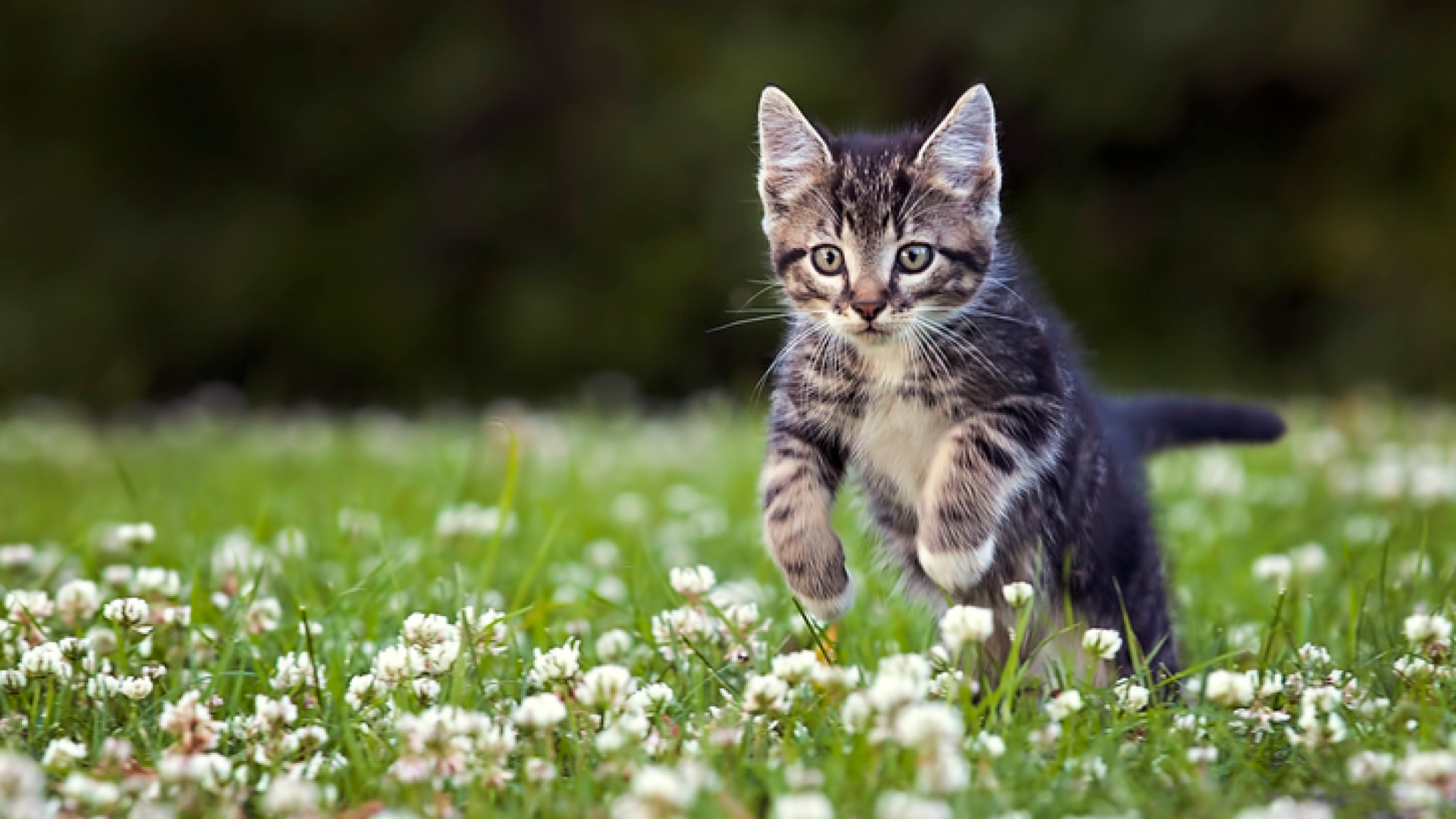Indoor cats vs outdoor cats: should you let your kitten outside?
Weighing up whether you should let your kitten or cat outside is a big decision for a pet owner. You’ll need to think about several factors, not only about the benefits for outdoor cats, but also how to keep cats safe outside. With some preparation and research, you can minimise the risks for your pet—and the stress for you, their owner—if you decide to introduce your cat to the outside world.
Article

What age can kittens go outside?
The answer, no matter what, is that they definitely shouldn’t go outside until a week after your kitten’s initial vaccinations are complete, so around 13-14 weeks old. Any earlier than that and your outdoor cat is at risk of picking up diseases such as cat flu. But ideally, your kitten should be a little older, around six months old (and definitely neutered), before they venture out alone. Younger kittens can, however, go outside accompanied by their owners.
What are the benefits of letting your cat outside?
There are benefits for outdoor cats, who get to roam, play and use their natural instincts as they would in the wild. Your outdoor cat will certainly get plenty of exercise and stay far from bored thanks to all the mental stimulation. They’ll also be able to scratch trees and fences, helping keep their claws and muscles in good condition.
What are the biggest risks for outdoor cats?
‘Is it safe to let my cat outside?’ is a question most new cat owners ask themselves early on in their pet-owning adventure. Closely followed by ‘how to let my cat outside without them running away?’. The list of risks outdoor cats face is fairly intimidating: diseases, parasites, fights with other cats, injuries, poisoning, cars and yes, getting lost or even stolen.
Indoor cats do face some risks too, most notably obesity and the health problems that can go alongside it if they are not active enough, but it’s fair to say that risks for outdoor cats outweigh those experienced by their indoor counterparts.

How to introduce cats to the outside world
Whether or not to let your cat outside is a decision only you can make, but knowing more about how to keep cats safe outside, or at least reduce the risks, should help you decide. Once you’ve made the choice, the preparations for letting your cat outside for the first time should begin, well in advance of their first outing.
Before your cat’s first outing, think about…
Getting your kitten used to people and other animals early on will give them confidence in the outside world.
Start training your cat to recognise and respond to their name before you let them outside.
If your cat gets lost, their microchip means any vet should be able to scan and identify them to get them safely home.
Sterilisation of your pet is a good idea for many reasons, including benefits for your kitten’s health, but it’s essential if you’re letting them outside, to eliminate the risk of an unwanted litter of kittens. Generally speaking, sterilised cats are known to stay closer to home than non-sterilised ones.
Buy a quick-release collar which will pop open automatically if caught on a branch or fence. Adding a little bell will reduce the risk of your cat’s natural hunting instinct harming the local bird population.
Make sure your cat’s vaccinations are up to date, as well as their tick, flea and worm treatments.
Cat-proofing your entire neighbourhood won’t be possible but you can minimise risks in your own space. Ensure any outside space your cat can access is free of poisonous plants such as lilies, chrysanthemums, tulips, daffodil bulbs and ivy. Check for other dangers: are there sharp tools or toxic chemicals stored in a shed? Are there small spaces a cat could get stuck in?
Think about how to keep your outdoor cat safe. If you’re near a busy road you’ll need to be sure your garden is securely enclosed.
If you’re home a lot, you can leave open a door or window for your cat to come and go, but if you’re mostly out, installing a cat flap will give them more freedom.
‘Should I let my cat out at night?’ is a question pet owners often ask themselves. There’s no right or wrong answer, but be aware that night-time outings carry a greater risk from traffic, attacks from other cats and predators such as dogs, foxes or raccoons. If you do decide to let them out at night, a reflective collar will help keep your outdoor cat safe at night by making them more visible.
If you want to let your cat out but are worried about the risks, a secure, covered area of your garden (sometimes known as a catio, or cat patio) that your cat can explore, is one way of finding a compromise, if you have space.

The big day: how to introduce cats to the outside
Choose a quiet day
If there’s a huge party or noisy building works going on at your neighbour’s house, consider postponing your cat’s first foray into the big, wide world in favour of a calmer day.
Make use of your kitten’s internal clock
Plan your kitten’s early outings for just before mealtimes, so you can rattle a bowl of kibble to tempt them back inside if necessary. But don’t start feeding your cat outside—when you want them to come back in, the lure of the food bowl may be useful.
Supervise at first
Early outings should not last too long. Leave the door open while you go outside and let your cat decide if they want to follow. The important thing is not really training your cat to go outside but making sure they are comfortable getting back in. Once you’re confident they can manage, you can start to leave them, for short periods at first
Be cautious, but trust your cat
It’s nerve-wracking to let your beloved pet outside for the first time, but once you’ve made the decision and taken all the necessary precautions, try to relax and enjoy your cat’s appreciation of the fresh air and greenery.
New territory: letting your cat out for the first time after moving
A house move can be stressful enough for humans, let alone felines. After the upheaval of the move, it’s best to keep your pet inside for a few weeks while they acclimatise to their new home, before letting them explore their al fresco territory. Take the opportunity to check the outdoor surroundings yourself: is the garden securely enclosed and free of dangers? Are there risks to be aware of nearby such as busy roads?
A cautious and patient approach is also important if you’re letting an indoor cat venture out for the first time. Letting indoor cats outside requires patience. First, let your pet get used to their new home and recover from the stress of the move. If you’re letting your cat out for the first time because they are new to your household, you should also keep them indoors for at least two to three weeks.
Indoor cats vs outdoor cats: what’s the answer?
As a responsible cat owner, you want the best for your pet, and that includes mental wellbeing as well as good nutrition and optimal health. The outside world provides many opportunities for play and stimulation. Outdoor cats certainly seem to be living their best life, chasing crunchy leaves, pouncing on flies or scratching their claws on the bark of trees.
But there is a downside: research shows that outdoor versus indoor cats’ life expectancy is much lower. They may not be out in the fresh air, but indoor cats can be healthier than outdoor cats, protected from risks including cars, fights with other animals, diseases and poisonous plants.
That’s not to say cats should not be allowed out—as their owner it’s up to you to decide whether it is safe to let your cat outside and whether their enjoyment of nature outweighs the inevitable risks.
Indoor cats can thrive in the right enriching environment. These tips will help you add stimulation and exercise to their surroundings.
- A vantage point. Cats appreciate a high perch from which to observe
- Hiding places. Either a cat tree with cubby holes or a plain old cardboard box
- Plenty of toys. Feathers or foam balls to bat
- Regular play sessions. Playtime with you is always fun
- Scratching posts. Important for keeping your cat’s claws and muscles in good shape
If you do decide to let your kitten outside, the right preparations should help your cat benefit from their excursions, and you should feel relaxed in the knowledge that you’ve done everything you can to help keep them safe.
Related Articles

Cats and dogs live together

What are the benefits of cat ID tags and microchips?
Like & share this page